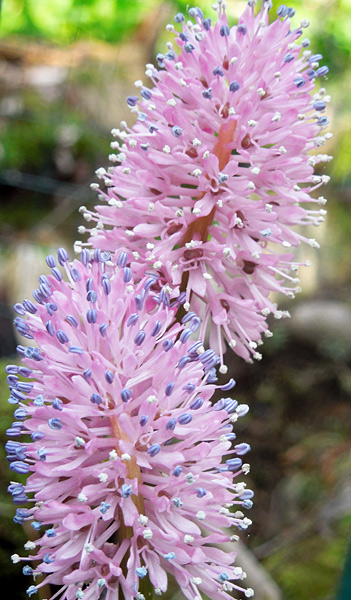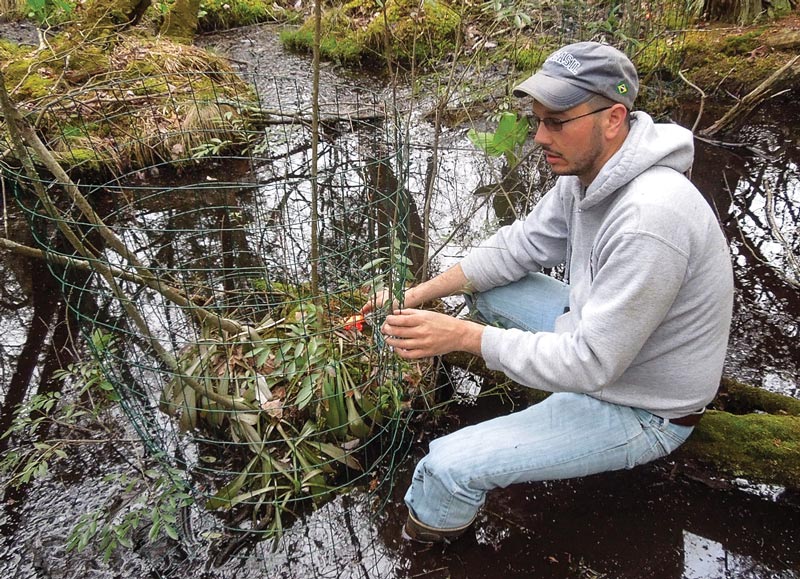
Bruce Bailey has never actually seen the beautiful bloom that gives the rare swamp pink plant its name. If not for the protection program literally under his feet, he might never get the chance.
At Shore Gate Golf Club in Ocean View, N.J., where Bailey — a 21-year GCSAA member — has been superintendent since June, a simple program to protect the threatened swamp pink (right) began in 2014. Most recent monitoring of the program shows those efforts have done wonders for the plant, which was once found from New York to Georgia but is now seldom found outside South Jersey.
“It’s been really successful,” says Michael Hogan, a botanist and program manager for the nonprofit South Jersey Land and Water Trust.
Swamp pink — Helonias bullata, the only known species in its genus — is a perennial member of the lily family. According to the U.S. Fish and Wildlife Service:
Swamp pink has smooth, oblong, dark green leaves that form an evergreen rosette. In spring, some rosettes produce a flowering stalk that can grow over 3 feet tall. The stalk is topped by a 1- to 3-inch-long cluster of 30 to 50 small, fragrant, pink flowers dotted with pale blue anthers. The evergreen leaves of swamp pink can be seen year-round, and flowering occurs between March and May.
Hogan describes swamp pink as a “canary in a coal mine,” and this particular canary has had a rough go because of development, wetland destruction and climate change. Swamp pink was listed as a threatened species in 1988.
More than half of the plant’s known populations can be found in New Jersey, and Hogan describes Shore Gate Golf Club, a half-hour’s drive southwest of Atlantic City, as a “Goldilocks” growing ground for swamp pink.
The 18-hole public golf course was built in 2002. Because it was to be constructed around a wetlands, the owners — the Turner family — had to adhere to environmental guidelines, including those from the New Jersey Department of Environmental Protection. One guideline required a buffer area three times larger than would have been required for a wetlands that didn’t house a federally threatened species.
Also at issue was a bridge that was to cross from the 12th hole to the 13th tee. That bridge was to run smack-dab through swamp pink central.
Rather than employ pilings, the Turners opted to install a suspension bridge over the wetlands. They also set aside a five-figure sum specifically for the swamp pink. That’s where Hogan and the South Jersey Land and Water Trust came in.
The nonprofit SJLWT — staffed largely, Hogan says, by “swamp pink people” — kept a close eye on Shore Gate’s swamp pink. It installed game cameras and found the greatest threat to this particular population had not two legs, but four. Because swamp pink plants are evergreen, they’re a particularly attractive — and obvious — target for deer. At Shore Gate, the hungry ungulates were chowing down swamp pink, preventing the plants from flowering and reproducing. “They were deer salad,” Hogan says.
In 2014, as a joint project of the SJLWT, NJDEP, U.S. Fish and Wildlife Service and Shore Gate, Hogan’s group took the Turner set-aside and installed welded cages, 3 feet tall and 2 feet in diameter, around 146 swamp pink plants in the Shore Gate wetlands.
“What was different was, they reached out to us,” Hogan says of the Turners. “We’re a nonprofit. It’s just interesting that a bunch of people from federal agencies, a public group and a nonprofit all came together for this.”

Phil Arsenault, a steward with the South Jersey Land and Water Trust, installs a protective cage around a swamp pink plant at Shore Gate Golf Club in Ocean View, N.J. Photos courtesy of Michael Hogan
The caging and resultant five-year monitoring program cost $35,000. And the swamp pink has flourished. In 2015, the 146 live plants had 288 rosettes, 1,730 leaves and 31 flowers. In 2018, they had 472 rosettes, 3,541 leaves and 126 flowers. And the SJLWT has found evidence that the swamp pink plants germinated and dropped seeds.
If golfers realize they’re in the presence of such floral rarity, they haven’t let on.
“Our golfers don’t seem to care that they’re there,” course co-owner Doug Turner says of the swamp pink plants. “There’s just a bridge that goes through the spot where they are. I never see anybody stop there. But a certain time of the year, (the blooms are) pretty neat.”
Which brings us back to Bailey, the course’s superintendent of four months or so. A South Jersey native, he was hired at Shore Gate a month or so after the swamp pink’s annual bloom. He has peered over the railings and can just make out a cage here or there.
“I have looked for it,” Bailey says. “They say it’s even more conspicuous in the winter because it stays green. I’ve done my research on it. It blooms in the spring. I want to see that.”
Andrew Hartsock is GCM’s managing editor.